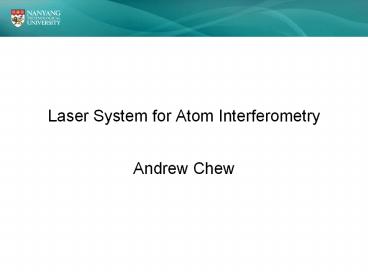Laser System for Atom Interferometry PowerPoint PPT Presentation
1 / 14
Title: Laser System for Atom Interferometry
1
Laser System for Atom Interferometry
- Andrew Chew
2
Content
- Overview of related Theory
- Experimental Setup
- Raman Laser System
- Frequency/Phase Stabilization
- Outlook
3
Atom Interferometry
- Similar to Light Interferometry
- Atoms replace role of the light.
- Atom-optical elements replace mirrors and beam
splitters
4
(No Transcript)
5
Motivation
- Light Interferometry is used to make inertial
sensors but the long wavelength limits the
resolution of the phase measurement. - The atomic de Broglie wavelength is much shorter
and thus allows for greater resolution of the
phase measurement. - Atoms have mass and thus we can make measurements
of the forces exerted on them. - An example would be the measurement of the
gravitation force.
6
Raman Transitions
- Stimulated Raman Transitions result in the super
position of e and g states - Two phase-locked Lasers of frequency ?1 and ?2
are used to couple the g,p and i,p hk1
states, and the e, p h(k1-k2) and i states
respectively. - A large detuning ? suppresses spontaneous
emission from the intermediate i,p hk1 state. - The ground states are effectively stable.
7
Ramsey-Bordé Interferometer
- A sequence of p/2, p and p/2 Raman pulses
- 1st p/2 pulse acts a beam splitter Places the
atomic wave in a superposition of g,p and e, p
hkeff states - p pulse acts a mirror Flips the g,p to the
e, p hkeff states and vice versa - 2nd p/2 pulse acts a beam splitter Projecting
the atoms onto the initial state.
8
Laser System
- Extended Cavity Diode Laser (ECDL) design used by
Gilowski et. al in Narrow bandwidth interference
filter-stabilized diode laser systems for the
manipulation of neutral atoms. Optics
Communications, 280443-447, 2007. - 3 Master Oscillator Power Amplifier (MOPA)
systems for each wavelength, each consisting of
an ECDL as the seeder and a Tapered Amplifier as
the amplifier. One MOPA is for cooling, another
two for Raman lasers. - Repumper laser consisting of one DFB laser diode.
9
Experimental Setup
- Laser system for Rubidium consisting of cooling
and repumper lasers for preparation of atomic
cloud. - Raman laser system for atom interferometry.
- Laser system for imaging and detection of
internal atomic states. - 1 set of laser systems for each individual
species of atoms used for interferometry
10
Raman Lasers
11
Raman Lasers
- The Raman lasers must be stabilized to stable
frequency references to ensure that the frequency
separation between them is kept at 6.84GHz. - The Raman lasers are overlapped to produce the
laser beat note. - The laser beat note is amplified and mixed with a
7GHz reference oscillator then filtered with a
low-pass filter to produce a 160MHz signal.
12
Raman Lasers
- The beat note is then passed into a PLL board
where the frequency divided by 2 and then is
compared against a 80MHz frequency reference
using a digital phase-frequency detector. - The signal is then filtered, integrated and two
outputs are produced one fast and one slow for
the laser current and the laser piezo feedback.
13
Vacuum System
- Vacuum Chamber consists of 2 glass cells and a
central metallic vacuum chamber. - A Titanium Ion-Getter Pump and A Titanium
Sublimation pump is attached to the Vacuum
chamber - The Ion Getter pump operates continuously, while
the Titanium Sublimation pump is operated
initially during baking and then switched off. - There are dispensers to introduce the Rubidium
and Cesium atoms into the vacuum system. - Prior to use, the vacuum system is baked with a
rotary vane pump and a turbomolecular pump
running together with other two pumps. - A Mass Spectrometer is used to monitor the gas
pressure levels. - We need a vacuum pressure of 10-10 mbar.
14
Outlook
- Near term we plan to complete the PLL for the
Raman Lasers - Next step is the Characterize the PLL
- And then work on other aspects such as getting
the detection beam ready etc. - Then We can do interferometry of Rubidium

